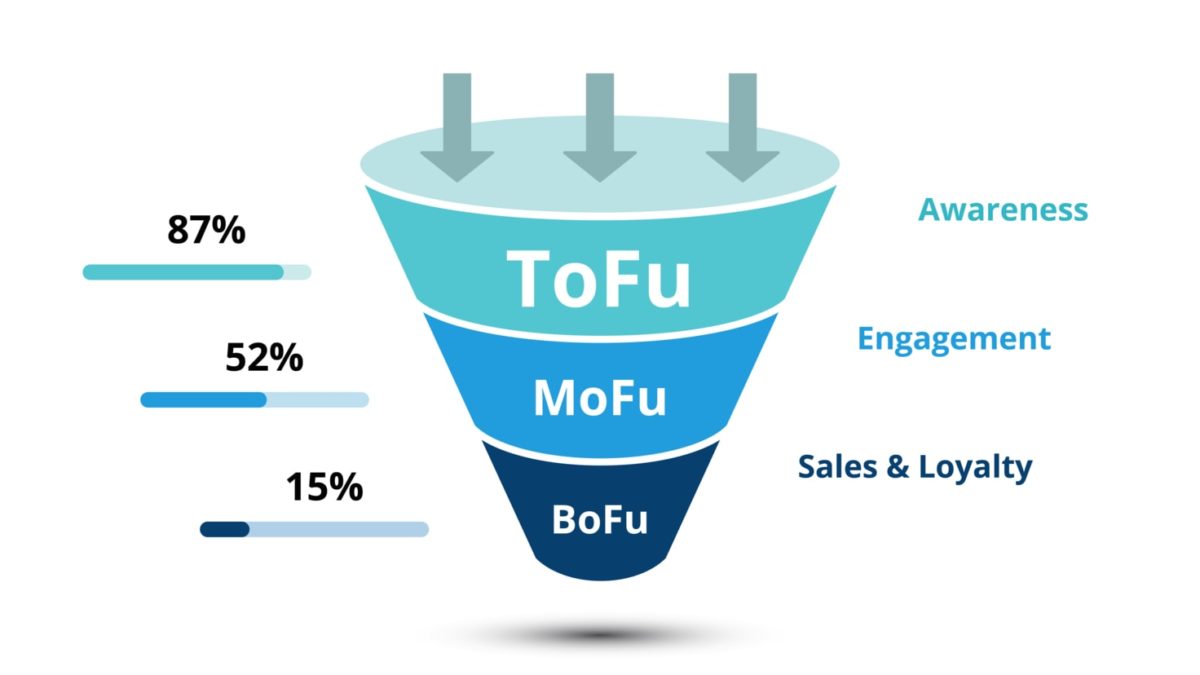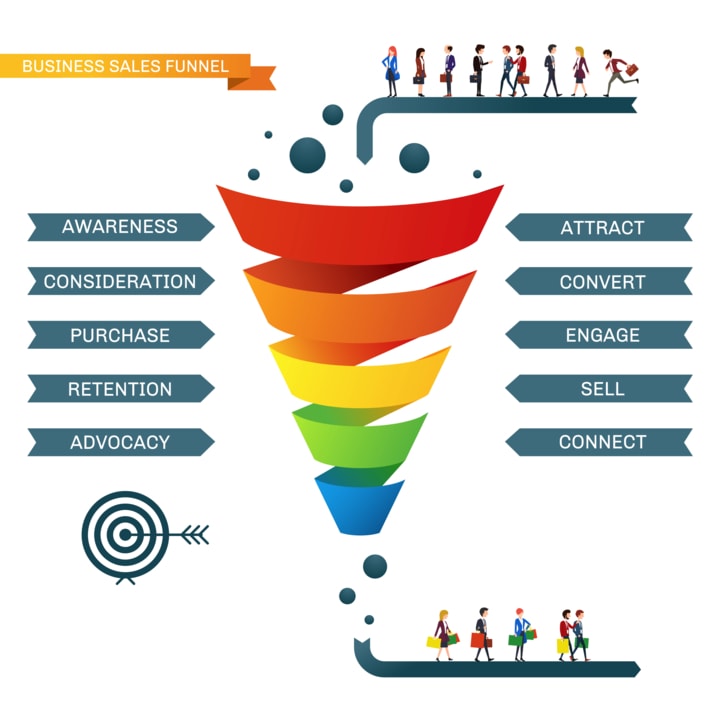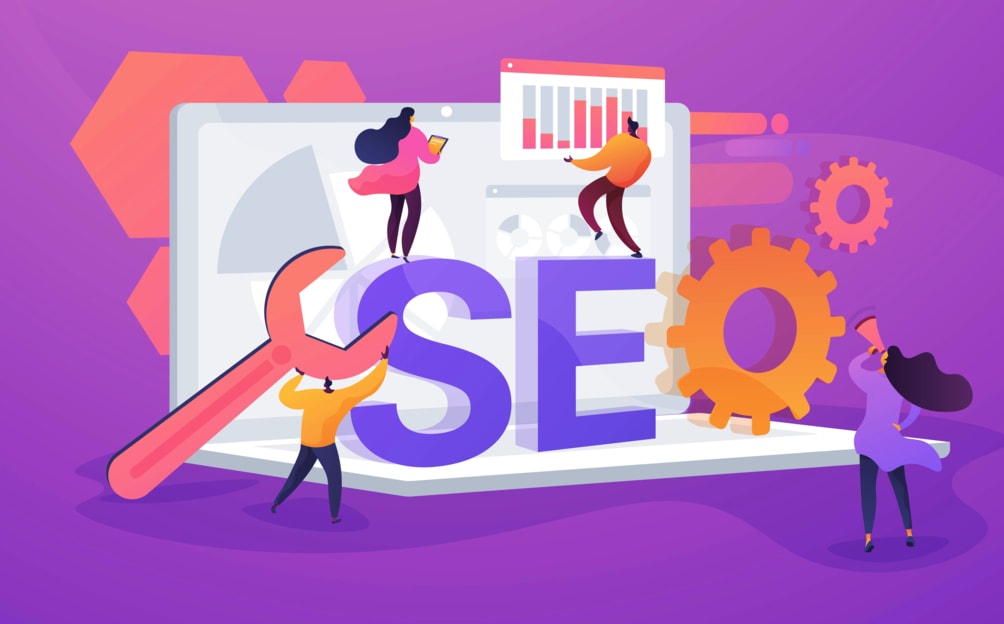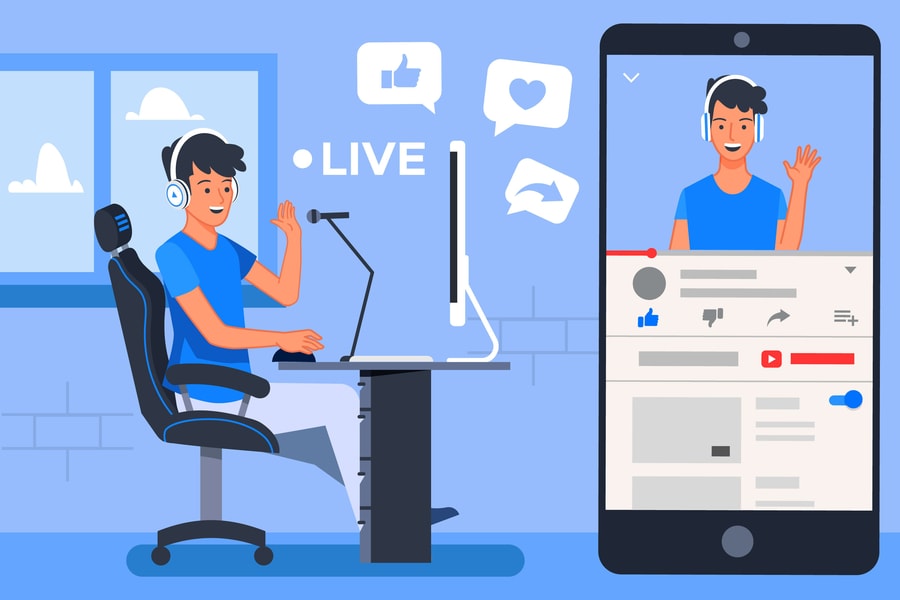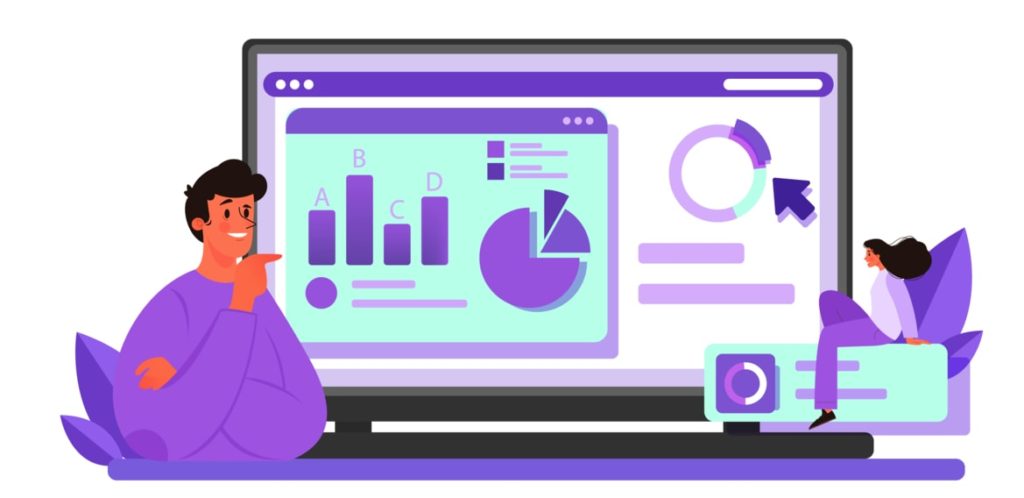Tofu, Mofu, and BoFu, the sales funnel every marketer needs for growth: Your primary business objective is to generate more leads and nurture and convert them into paying customers.
These activities help you make more sales, increase revenue, and scale your business. But it is challenging to convert prospects into buyers because they have to walk through multiple stages down the sales funnel to qualify.
Indeed, a survey reveals that 50% of prospects are not ready to make purchases even after qualifying as leads. Thus, the sales or conversion funnel plays a crucial role.
This article will cover the following areas:
- What are sales funnels in inbound marketing?
- Why is a sales funnel essential for growth?
- Understanding the sales funnel stages
- Examples of sales funnels
- Types of content to create for each step of the funnel
- The value of content in the sales funnels
- Creating a sales funnel template to scale your business
- How to know that your sales funnel is working
So, let’s get started with the definition of a sales funnel.
What is a Sales Funnel?
Sales funnel definition: A sales funnel, also called a conversion funnel or sales pipeline, is the visual representation of the buyer’s journey. This journey starts at the top of the funnel (ToFu), portraying the awareness stage to the bottom of the funnel (BoFu) or conversion.
B2B sales funnels map out the journey or process a customer goes through before purchasing. Each step of the consumer journey takes him from one stage to the next until the final stage of the conversion funnel.
*IMPORTANT* Sales funnels work for all kinds of businesses. For instance, you can build a sales funnel for affiliate marketing, SaaS sales funnel, email sales funnel, and ecommerce sales funnel.
Why is a Sales Funnel Essential for Growth?
You may ask, ‘do I need a sales funnel for my business? Yes, You do because a conversion funnel is vital for your inbound marketing strategy.
A durable funnel determines the action you apply to persuade prospective customers to go further down the funnel and take action. Please, note that consumers are not readily going to buy your new product or use your new service.
Instead, they will research the product or service, compare competitors’ products, and read customer reviews before purchasing. These activities are customers’ learning and consideration processes that would help them make a better buying decisions.
And it often takes longer to decide. It is essential to consider the buyer’s journey and create a sales funnel that resonates with your business. This approach involves developing audience personas or buyer profiles to help you understand your target market and how to walk them through their journey.
Remember, you may have the best product or service in the market and still not generate sales. So, making sales and increasing your business growth ratio will depend on one critical element — your ability to convert leads into customers and repeat buyers.
One of the best ways to convert more leads is to create a sales funnel to amplify your marketing strategy and sales pipeline.
Understanding the Stages of the Sales Funnel
Understanding the sales funnels is crucial as it enables you to become an efficient marketer. The knowledge helps you know:
- How consumers go through the sales funnel
- How to engage and qualify readers to leads
- The best answers to provide customers with questions concerning your business
- The best ways how to address consumers’ issues
Also, understanding the funnel stages enables you to sort leads into appropriate groups to provide excellent customer experiences at all levels. You will be able to create critical touchpoints that influence each lead segment to take action and convert.
Additionally, it helps you create marketing content that captures consumers’ attention during their journey, increases website engagement, and boosts sales conversions.
For this, clever marketers visualize a customer journey using an evergreen sales funnel. However, you can structure your funnel in several stages based on your business model or industry. But the sales funnel is usually segmented into five levels under three primary groups.
What are the Sales Funnel Stages?
Let us look at the primary sales funnel stages:
Top of the funnel (ToFu)
- Awareness
- Interest
Middle of the funnel (MoFu)
- Consideration
- Evaluation
Bottom of the funnel (BoFu)
- Purchase/Conversion/Action
We will discuss these various funnel phases a bit, starting with the top funnel:
TOFU — Awareness & Interest
The ‘Awareness’ phase is where prospective buyers get to know or become aware of the products or services you offer. It is their first exposure to your business, which could be through blog articles, social media posts, paid or organic search, and other marketing channels.
When customers first interact with your business, they would want to know more, such as the values your company can provide to address their problems. So, it would help if you educated them at this stage to build or increase customers’ desire for your brand and move them to the interest phase.
This stage is where potential customers determine whether your brand is worth their time. Consumers become aware of your offerings at the top funnel and indicate interest as leads by digging for more information.
So, The ‘Awareness’ phase of the sales funnel is where lead generation occurs. Remember, generated leads are not acquired, customers. They must go further down the marketing funnel to convert into paying customers.
MOFU — Consideration & Evaluation
Would-be buyers showed interest in your brand after becoming aware of your products. So, at the middle funnel (Consideration & Evaluation) stage, consumers consider switching brands by evaluating your offers with other alternatives.
Customers are at this funnel level because they feel that your products can improve their lives. But they’re not entirely convinced that your offer is the best solution to their problems.
Given this, they start comparing your brand with competitors. Your job at this point is to nurture your leads and convince them to buy from you. MoFu is where lead acquisition takes place.
But acquiring leads is not guaranteed that they will convert to paying customers. Your acquired leads must walk to the bottom of the revenue funnel to convert.
BOFU — Conversion/Action/Purchase
Consequently, after researching your services and comparing them with the competition, your leads land at the BoFu — action/conversion stage. Here is where they decide to take action.
However, keep in mind that some leads may not convert at this stage. Why? Because they might need a bit more persuasion to complete your desired goal.
For this, intelligent marketers use FOMO marketing tactics, such as ‘limited offer,’ ‘sales end tonight,’ and more, to provoke customers to action. As a result, shoppers take action by purchasing your product or paying for your services and convert to paid customers.
So, lead conversion occurs at the bottom of the sales funnel. It means that sales funnel marketing embodies the entire operation of potential customers from the first point to the bottom level of taking action.
Essentially, consumers embrace distinct perspectives as they progress from one stage of their journey to the next. So understanding the B2B sales funnel is vital to helping you create helpful content that meets your audience at every step of their journey.
Do you want to build an effective ToFu MoFu BoFu sales funnel to scale your business?
Sales Funnel Examples
Below are a few of the best sales funnel examples to inspire your campaign.
Social Champ’s Sales Funnel example
Social Champ is a social media marketing tool that offers multiple features to create and manage social posts and messages. With a focus on content marketers and social media managers, Social Champ can help businesses build their online presence.
Social Champ’s sales funnel is efficient because the SaaS company uses different marketing content to walk potential clients through the conversion funnel.
Types of content the team uses to transport clients through its B2B sale funnel are:
- Blog posts
- YouTube videos
- Email newsletters
- Social media posts
- Twitter chats
- Free trials
As a result, the subscription-based business persuades prospective clients that they are a trusted authority for their social media management needs.
ConvertKit’s Sales Funnel example
ConvertKit is a SaaS subscription tool that allows authors, bloggers, and content creators to produce and design marketing emails. The software also enables users to create excellent landing pages and newsletter sign-up forms to power their email marketing campaign.
ConvertKit walks potential customers through its conversion funnel using various educational materials that convert.
Some content formats the team at ConvertKit use includes:
- How-to guides
- Blog articles
- Podcasts
- Videos
- Case studies
- Webinars
- Workshops
As a result, ConvertKit grows its audience base and profit from word-of-mouth marketing, given its sales funnel marketing approach. Satisfied customers gladly tell other creators about the SaaS product via referral marketing.
And using case studies, the company targets a defined audience (content creators). These tactics make the brand applicable to its target market.
Sample sales funnel by Mailshake
Mailshake software is a lead generation app that enables marketers to automate their lead generation campaigns and streamline the process. The lead generation prospecting software helps businesses promote their content, build relationships, and generate leads on autopilot.
Like the other conversion funnel examples above, Mailshake’s team uses different content marketing strategies to boost conversions.
Types of content they use include:
- Customer testimonials
- Blog posts
- Product demos
- Product descriptions
- Live training
- Webinars
This content marketing strategy strengthens Mailshake’s sales pipeline and makes its funnel more result-oriented or successful.
Thus, Mailshake’s sales funnels get results because its content creators customize each content to the specific needs of Mailshake’s audience at every step of their journey.
14 Types of Content to Create at Each Stage in the Sales Funnel
To create content that connects with readers on all customer journey stages, you must know your audience and understand how they interact with your website. This is true if you build an evergreen sales funnel of course but also if you build a temporary one.
And the best approach to understanding website users is to develop a customer journey map. Please, hold your breath. I will discuss customer journey mapping before the conclusion of this article.
This undertaking will help you produce blog content that gets results at all sales funnel levels. The type of content you deliver may positively or negatively influence your readers.
Here are the content formats you should focus on to amplify your conversion campaign.
Content formats for top of the funnel (ToFu)
When developing marketing content for the ToFu level, your primary objective is to publish content that enhances your online visibility. The content should drive more organic traffic and create awareness for your new business.
Ultimately, your content marketing goal at this stage is to make more people aware of your new products or services. So what types of content work at the top level funnel?
1. Data-driven blog posts optimized for SEO
Why does SEO data-driven blog content work? Because they attract long-term organic traffic and help you build awareness for your brand. Blog post writing is one of the best marketing methods for driving consistent web traffic to your blog or product/landing page.
But your blogs cannot get results if you fail to optimize your content for SEO. A well-optimized blog will increase your visibility on searches long-term and build brand recognition.
Also, data-oriented content will attract other marketers, bloggers, and content creators to link to the post. The more backlinks you acquire, the higher your ranking on search results.
Such content lets you overcome one of the sales funnel challenges at the top level of your content marketing strategy. It makes you unique and stands out from information overload.
Speaking of information overload, when I was writing this blog content, publishers had already published, sent, or circulated:
- 270 ml newspapers
- 163 billion emails
- Over 5-million blog posts
- 498 tweets on Twitter
With this amount of information online, more than 5-billion internet users have searched Google already. So, how can you put your content in front of people searching for the post you published?
Prioritize blog content optimization and optimize your website to help users find your brand and drive growth. The more SEO search visibility you generate signifies more brand visibility and higher ranking.
Note that visitors clicking your link from search results look for helpful information. So include valuable data from trusted sources to support your claims. Also, strengthen your copy with powerful words to get the best results.
2. Guest blogging
Some marketers say guest blogging is dead, but in reality, guest posting on relevant authority sites is one of the best ways to build brand awareness.
Those top industry blogs already have the target readers and buyers you intend to bring to your blog. So, by writing for other industry sites, you’re exposing your brand to their audience, who happens to be your focus market.
Moreover, guest post submissions enable you to grow your blogging community and social media followers and increase inbound links. These signals add up and improve your search ranking position and brand authority.
But first, you have to build relationships with site owners, content managers, and blog editors to land guest blogging opportunities.
3. Social media videos
Social media platforms are more about visual content, and among the top performers is video content. And social media marketers love video marketing since it entertains viewers and keeps them longer on the page.
Research indicates that 88% of consumers will prefer to see more business videos in 2022. So the social web algorithms favor video content and move it to the top of users’ streams.
Your videos should be informative, practical, and consistent with your brand message to boost visibility and awareness.
Here are the types of videos you should be creating if you want your social media videos to get results. The best-performing videos are those with practical tips on how to do something.
For example, based on your niche market, you can produce a short video detailing:
- How to create an eCommerce store and make your first sale in 24 hours
- How to increase product adoption for your SaaS subscription product
- A step-by-step guide to building a WordPress blog that makes money
Videos on these and similar topics can quickly go viral, signaling to Google bots that your content is valuable to your audience. However, don’t confuse virality for organic traffic since
your social videos may go viral while your CTR remains low.
4. Publish interviews and expert roundup posts
Interviews and expert roundup posts are excellent traffic drivers with high click-through rates (CTRs) and social media shares. Why does this type of blog content generate more engagement?
Because web owners and content marketers develop these materials in collaboration with industry experts and influencers, thus, the participants you mentioned will gladly share (co-promote) the content with their followers.
Your business will reach a wider audience, build brand recognition, and bring new readers & subscribers, and interested prospects. But you must first learn how to write expert roundups and conduct interviews with influencers.
Content types for middle of the funnel (MoFu)
The middle funnel content should entertain your readers and keep them coming back. Content at this stage of the sales funnel is crucial for growth. But when readers are not coming back after the first visit, it indicates weakness.
So, you should amplify the MoFu to increase social media engagement, drive web traffic, and grow your email marketing list.
The following types of content work best:
5. How-to blog posts & videos
Consumers show interest in your services at the top level funnel and move to the middle funnel. They’re looking for blog content that shows them how to perform a task or solve their problems.
These site visitors are searching for how-to information on related topics. So the post you create should focus on attracting do-it-yourself (DIY) readers — people whose primary aim is to resolve their challenges.
You become their go-to resource by providing helpful blog posts on related topics. Accordingly, many site visitors might move down to the bottom of the funnel and pay for your services.
So, create more how-to blogs to help you:
- Build a loyal readership
- Grow your email list
- Establish your thought-leadership
- Get more social signals (likes, shares, comments, and improve your brand’s social media visibility). These social media signals will help boost your SEO techniques; they contribute to your site’s search ranking.
Try creating how-to videos besides blog posts and articles since many visitors may prefer to watch videos than reading text materials. The video content statistics cited above reveal some exciting video marketing results.
6. Original research data
Besides producing how-to blogs and video content, write and publish original research data. Original research is excellent for driving inbound links as bloggers, content marketers, and creators use the information to back up their posts.
“Research is creating new knowledge.” – Neil Armstrong.
As Neil’s quote points out, you’re creating new knowledge that others would like to leverage and build backlinks to your site. Your blog or website will become marketers’ primary source of research information.
According to Influence & Co, original research is one of the top five content types that earns inbound links. Look at sites like Content Marketing Institute, Statista, HubSpot, and the like; they publish more industry research reports. And content creators link to their data for references.
Furthermore, BuzzSumo and Mentris’ Research report shows that 90% of brands found original research successful. Indeed, 56% of the respondents say their research met or exceeded their content marketing expectations.
Additionally, over 90% of respondents who use original research data plan to conduct more research.
Why original research content works
Here is my take on why this type of marketing content works:
- Original research creates new unique content that other marketers need.
- Data research documents increase CTRs. According to LinkedIn Marketing Solutions, adding numerical data to status updates can increase post impressions by 167% and CTRs by 37%
- Research data strengthen your marketing and sales messages. The data supports your claim and can boost conversions.
- Innovative research content makes your blog or website the primary source of industry information, helping you get more quality backlinks.
Ultimately, original research will make your blog or website a trusted industry resource for information.
7. Email marketing sequences
People who move to the middle funnel want more convincing to go further to the bottom of the conversion funnel. So they confirm their interest by submitting their email contacts. What would you do with those email addresses?
It’s time to use a marketing automation tool to send them sequences of emails since they find your content entertaining and valuable. Otherwise, they would not have submitted their contacts.
Sending a series of emails helps you promote your:
- Recent blog posts and products or services
- Engage, nurture and qualify leads
- Boost conversions.
One of the best email marketing hacks is to add CTAs in your emails to direct recipients to click your page link or share the content with their friends. These activities allow you to drive traffic to your blog, landing page, or the product page.
It also lets you build relationships with email recipients. Therefore, start with welcome emails. Then follow up with a series of email campaigns that include links to your landing page or blog to provide more helpful content.
Using an email marketing tool to send welcome emails will activate a series of marketing emails that supports your overall marketing objective.
8. Live webinars
Live webinars are incredible ways to build emotional connections with your target audience, existing customers, and eventual buyers. Webinars work well because they let you answer viewers’ or attendees’ (your audience) questions in real-time.
Essentially, you’re using an interactive platform to meet new and existing audiences and provide valuable real-time information. You get to understand your audience better through live webinars.
Also, you’re educating hundreds or thousands of global audiences while building awareness for your brand. The purpose of webinars is to demonstrate and instruct while delivering knowledge.
Did you know? Webinar attendees are people who’re toward the end of the middle funnel. So it’s easy to move them to the bottom level and convert them to paying customers.
Given this, live webinars should be part of your content marketing strategy. Also, live events offer a platform to repurpose your top-performing blog posts and collaborate with industry experts and influencers.
Thus, making live webinars & events part of your content marketing mix will enable you to reach your target goal on all customer journeys.
Content formats for the bottom of the funnel (BoFu)
You must have generated some leads at this level of the marketing funnel. Hence, your goal is to build credibility with site users and convince them to take your desired action to improve conversions.
But if your conversion rate is low, you need to reinforce the bottom of the funnel using appropriate marketing materials. Remember, your main aim right now is maximizing the bottom of your conversion funnel. Therefore, the following content formats work best at this level.
9. Sales enablement content
You might ask, what is sales enablement? The sales enablement content is marketing content that the sales team uses to engage and address consumers’ concerns during the sales process.
But you may not have a sales team. So your sales enablement is any content you create particularly to help a customer make a buying decision. This type of content must add value to your readers if you want to convert them.
The sales enablement statistics by G2 reveal that:
- The popularity of sales enablement skyrocketed by 343% in adoption in the past five years.
- 76% of brands increased sales significantly by 6% — 20% after including sales enablement content into their marketing strategy
- 84% of sales representatives met their goal because employers integrated sales enablement strategy into their B2B marketing mix
- 65% of marketing and sales managers confirmed their top marketing challenge; the lack of sales resources to carry out their jobs properly. (These marketers don’t meet their quota due to the lack of sales enablement materials).
Moreover, considering that over 75% of marketers forget to add sales enablement in their content marketing strategy, it gives you a competitive advantage to employ it.
Marketers get stuck between choosing the best product or marketing automation tool for their business. For this, sales enablement content is what they need to help them out.
Types of sales enablement content to close more deals
Your content for sales enablement should have appropriate information delivered to the right audience when they need it and through the proper channel.
If that makes sense to you, let’s consider a few types of sales enablement content you should focus on for more conversions.
10. Case studies
Case study content formats are amongst the top marketing content that drives conversions. Why is that so? They display real-time examples of happy customers who used your product and how it worked.
A case study presents detailed accounts of an issue and how a customer used your services to solve the problem. This type of content works well in any industry since it demonstrates characters with conflict and resolution.
Thus, reading case studies of real people can strengthen consumers’ trust in your brand. So add case studies to your sales enablement content strategy. Also, ensure to amplify your case study copy with statistics/data to increase conversion rates.
11. Customer testimonials
As case studies, customer testimonials are insanely valuable in that they transform your marketing message into evidence. By showing the benefits a client experienced using your product, testimonials give proof of your brand authenticity and expertise.
This type of content can be in various formats. These include text materials (customer reviews, social media posts, etc.), podcasts (digital audio files), and visual content (videos & static images).
Testimonials are unbiased user-generated content that offers powerful credibility to your sales promises. It tells consumers that you can deliver according to your assurance and can quickly convert them.
12. Ebooks
E-books are extended versions of blog posts as they’re more comprehensive. A free ebook can be a powerful marketing tool, especially for those seeking helpful information with little or no budget.
These content materials can be a valuable solution in building brand loyalty and increasing lead generation. And while e-books help improve business/customer relationships, it would help to speak with your sales team or conduct audience research before writing your ebook.
In that way, your downloadable copy will answer vital questions your target market may have. You guide users toward your final conversion goal by answering their queries in ebooks. Consider using an e-book template when creating your ebooks.
Build a successful ToFu MoFu BoFu sales funnel to leverage your business now!
13. Social media content
Social media networking sites offer marketers and sales reps a high converting platform to generate and convert more leads. The content you post across social media is essential for sales enablement solutions.
Your social media messaging gives you the foundation for healthy engagements with prospective customers and existing clients. You can share links to well-crafted blog articles or YouTube videos and podcasts.
This social media content helps you maintain an active presence and build relationships with your target market. If you share links to posts your followers find exciting, they can click to your landing page and possibly convert to buyers.
14. Sales or service page content
Your service page/sales page is one of the most critical pages on your site. It gives visitors an overview of your services and proves that you’re the right person to solve their problems.
But the page must have these elements to be effective:
- A compelling title that grabs readers’ attention
- Entertaining copy that keeps visitors reading
- Trust signals (positive client reviews or testimonials)
- Answer consumers’ pressing sales questions with evidence
- Ease of use order form
- Irresistible calls-to-action (CTA)
Ultimately, optimize your sales or service page with commercial intent keywords to boost conversions. You can create several content formats to enable sales and optimize other funnel levels. But the few above will do!
The Value of Content in the Sales Funnel
“The buyer journey is nothing more than a series of questions that must be answered.”
— Michael Brenner.
Is Michael’s quote worth noting? Yes! Because content marketing enables consumers and online users to find answers to their questions.
Marketing content helps your target audience and leads make reasonable buyer decisions. The informative content you share guides readers to pick the best product or service as a solution for their needs. That’s the power of content in the sales funnel.
So, for your marketing and sales funnel to get results, you must prioritize producing valuable content that helps your readers.
Such marketing material must do the following tasks:
- Provide helpful answers to readers’ questions
- Inspire users’ interest in your brand
- Trumps consumers’ objectives
- Establish trust and credibility with your audience and prospects
- Build long-term relations with potential buyers.
Your blog posts should be of excellent value because value-added content is the best sales and marketing tool. Thus, the right content will guide consumers from the top to the bottom of the digital sales funnel.
Creating a Sales Funnel Template To Scale Your Business
What are sales funnel templates? Sales funnel templates are structures or maps of consumers’ journey from the first point of awareness to conversion as paid customers.
But the customer map doesn’t start from the awareness stage. It begins with the customer engrossed with thoughts of what he needs to buy and continues to where he finds the item and adds it to his online cart.
You can use a customer journey funnel to create sustainable sales funnel templates to grow your business.
How To Know That Your Sales Funnel is Working
Having a sales funnel is no guarantee that it works. It would help to ensure that your effort will pay off. The best place to start is setting and assigning marketing metrics to monitor.
Therefore, allocate KPIs for each funnel stage to enable you to monitor and measure your performance. The data you collect will determine your successes and failures and help you make necessary adjustments.
You will also know more about your target market and pinpoint marketing tactics that better connect them.
Final Thought on ToFu MoFu BoFu – Sales Funnel
As potential buyers become aware of your brand, they starve for more content. So, conversions occur across multiple touchpoints and marketing channels.
Therefore, advocating for sales earlier on the customer journey is not the best marketing practice. But it helps to use a functional sales funnel to power your digital marketing strategy. It will help you build relationships with your target market, and persuade them to convert.
As a result, you will build a loyal community of repeat buyers and extend customer lifetime value (CLTV).
Growth Hackers is an award-winning digital marketing and growth hacking agency helping businesses from all over the world grow. There is no fluff with Growth Hackers. We help entrepreneurs and business owners create high-converting ToFu MoFu BoFu sales funnels, generate qualified leads, optimize their conversion rate, gather and analyze data analytics, acquire and retain users and increase sales. We go further than brand awareness and exposure. We make sure that the strategies we implement move the needle so your business grow, strive and succeed. If you too want your business to reach new heights, contact Growth Hackers today so we can discuss about your brand and create a custom growth plan for you. You’re just one click away to skyrocket your business.

